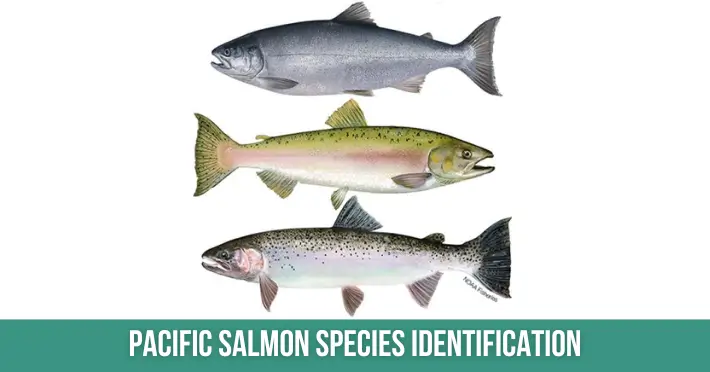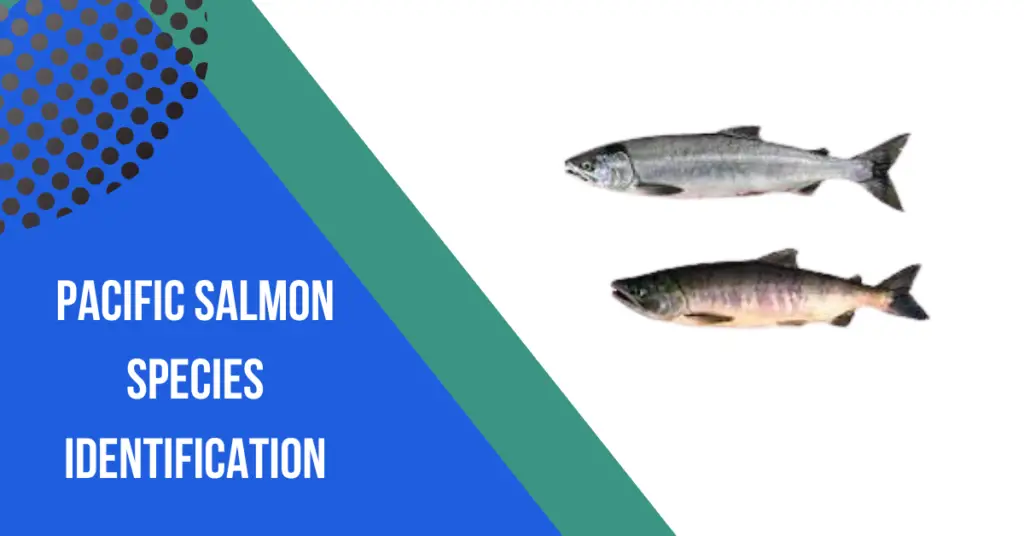Contents
- 1 Pacific Salmon Species Identification:
- 2 Physical characteristics for identification:
- 3 Behavioral differences between species:
- 4 Spawning behavior:
- 5 Feeding behavior:
- 6 FAQs:
- 7 Q: What are the main physical characteristics used for identifying Pacific salmon species?
- 8 Q: How do behavioral differences between species help in identifying Pacific salmon?
- 9 Q: Why is accurate identification of Pacific salmon species important?
- 10 Q: How can genetic testing be used for species identification in Pacific salmon?
- 11 Q: What are some common Pacific salmon species and their distinguishing features?
Pacific salmon species identification is the process of distinguishing between the various species of salmon found in the Pacific Ocean and its tributaries. There are several species of Pacific salmon, including Chinook (also known as King), Coho (also known as Silver), Sockeye (also known as Red), Pink (also known as Humpback), and Chum (also known as Dog).
These species can often be distinguished by their physical characteristics such as size, coloration, and markings, as well as by their behavior and habitat preferences.
Additionally, genetic testing and anatomical features such as the number of gill rakers and the shape of the tail can also be used to differentiate between species. Accurate identification of Pacific salmon species is important for fisheries management, conservation efforts, and scientific research.
Pacific Salmon Species Identification:
Pacific salmon species identification refers to the process of distinguishing between the various species of salmon found in the Pacific Ocean and its tributaries.

This identification involves assessing physical characteristics such as size, coloration, markings, and anatomical features, as well as observing behavioral differences and, in some cases, utilizing genetic testing.
Accurate identification of Pacific salmon species is essential for effective fisheries management, conservation efforts, and scientific research.
Fisheries Management: Different species of salmon may have varying population sizes, growth rates, and susceptibility to fishing pressures. Understanding the composition of salmon populations helps fisheries managers implement appropriate regulations to ensure sustainable harvesting practices and prevent overfishing of any particular species.
Conservation: Some species of Pacific salmon are listed as threatened or endangered,
such as Chinook salmon in certain regions. Accurate identification allows conservationists to track the status of these populations and develop targeted conservation strategies to protect their habitats and promote recovery efforts.
Ecosystem Health: Salmon play a vital role in ecosystem dynamics, serving as keystone species that influence the structure and function of aquatic ecosystems. Identifying different salmon species helps researchers monitor ecosystem health and assess the impacts of environmental changes, pollution, and habitat degradation on salmon populations and their associated ecosystems.
Scientific Research: Accurate species identification is fundamental to scientific studies investigating various aspects of salmon biology, ecology, and behavior. Researchers rely on correctly identifying species to analyze population dynamics, migration patterns, genetic diversity, and evolutionary relationships, contributing to our understanding of these iconic fish and informing management decisions.
Economic Importance: Pacific salmon support commercial, recreational, and subsistence fisheries valued at billions of dollars annually. Accurate species identification ensures that harvested salmon are correctly labeled and marketed, maintaining consumer confidence and preventing mislabeling or fraud in seafood products.
Overall, accurately identifying Pacific salmon species is essential for effective management, conservation, scientific research, and sustainable utilization of these valuable resources.
Physical characteristics for identification:
Physical characteristics play a key role in identifying different species of Pacific salmon. Some of the main physical features used for identification include:
Size: Pacific salmon species vary in size, with some species being larger than others. For example, Chinook (King) salmon are generally the largest species, while Pink (Humpback) salmon are typically the smallest.
Coloration: Each species of Pacific salmon exhibits distinctive coloration patterns, which may change depending on their life stage and habitat. Chinook salmon often have a metallic greenish-blue coloration on their back and silver sides, while Sockeye (Red) salmon are known for their bright red bodies and green heads during spawning.
Markings: Many Pacific salmon species have characteristic markings or patterns on their bodies, fins, and tails. For instance, Coho (Silver) salmon typically have small, dark spots on their back and upper tail fin, while Chum (Dog) salmon have distinct vertical bars on their sides and an irregular blotchy pattern on their back.
Anatomical features: Certain anatomical features, such as the number of gill rakers, the shape of the tail, and the presence of teeth, can also be used to differentiate between species. For example, Chinook salmon have a relatively small number of gill rakers compared to other species, and they often have dark gums and large teeth.
By carefully observing these physical characteristics, along with behavioral traits and habitat preferences, scientists, fisheries managers, and enthusiasts can accurately identify the various species of Pacific salmon.
Behavioral differences between species:
Behavioral differences between species of Pacific salmon can provide valuable clues for identification. Some of the main behavioral differences include:
>> Spawning behavior: Different species of Pacific salmon exhibit distinct spawning behaviors, including the timing and location of their spawning migrations, as well as their preferred spawning habitats.
For example, Chinook (King) salmon tend to spawn in larger rivers and streams, often traveling long distances from the ocean to reach their spawning grounds, while Pink (Humpback) salmon typically spawn in smaller streams and estuaries closer to the ocean.
>> Feeding behavior: Pacific salmon species may have different feeding preferences and strategies depending on their life stage and habitat. Chinook salmon, for instance, are known for their aggressive feeding behavior and ability to capture large prey, while Pink salmon primarily feed on smaller prey such as zooplankton and small fish.
>> Habitat preferences: Each species of Pacific salmon has specific habitat requirements for different stages of their life cycle, including freshwater rearing, migration, and spawning. These habitat preferences can vary based on factors such as water temperature, flow rate, substrate type, and food availability.
Understanding the habitat preferences of different salmon species can help identify them based on the characteristics of their environment.
By observing these behavioral differences, along with physical characteristics and other factors, researchers and enthusiasts can accurately identify the various species of Pacific salmon and gain insights into their ecology and biology.
Spawning behavior:
Spawning behavior varies among different species of Pacific salmon and can provide valuable insights for identification. Chinook (King) salmon, for example, typically undertake long spawning migrations, often traveling hundreds of miles upstream from the ocean to reach their spawning grounds in large rivers and streams.
They are known for their ability to jump waterfalls and navigate through obstacles to reach suitable spawning habitat. In contrast, Pink (Humpback) salmon tend to spawn in smaller streams and estuaries closer to the ocean, often in shallow, gravelly areas.
They exhibit a unique “humpbacked” appearance during spawning, with males developing a pronounced hump on their back. Sockeye (Red) salmon are known for their mass spawning events, where large numbers of fish congregate in freshwater lakes and rivers to spawn simultaneously.
Observing these spawning behaviors and other physical and behavioral characteristics can help differentiate between species of Pacific salmon.

Feeding behavior:
Feeding behavior is another important aspect that varies among different species of Pacific salmon and can aid in their identification. Chinook (King) salmon are apex predators known for their aggressive feeding behavior.
They have large mouths and powerful jaws, allowing them to capture and consume a wide range of prey, including fish, crustaceans, and squid.
Coho (Silver) salmon also exhibit predatory behavior but tend to feed on smaller prey such as insects, small fish, and plankton. They are often found in nearshore coastal waters where they hunt for food in kelp forests and other productive habitats.
In contrast, Pink (Humpback) salmon have a unique feeding strategy during their oceanic phase. They primarily feed on zooplankton, including copepods and krill, using their gill rakers to filter small prey from the water. This specialized feeding behavior influences their appearance and physical characteristics, such as their small size and streamlined body shape.
Similarly, Chum (Dog) salmon feed on a variety of prey items during their time in the ocean, including small fish, squid, and crustaceans. However, they are also known to scavenge on dead and decaying organisms, earning them the nickname “Dog” salmon.
Observing the feeding behavior and dietary preferences of Pacific salmon can provide valuable clues for species identification, especially when combined with other physical and behavioral characteristics.

Conclusion
In conclusion, accurately identifying Pacific salmon species is essential for effective fisheries management, conservation efforts, and scientific research. Physical characteristics such as size, coloration, and markings, along with behavioral traits such as spawning behavior and feeding preferences, provide valuable clues for distinguishing between species.
Understanding the unique traits and behaviors of each species allows for informed decision-making in managing and protecting these valuable resources.
By combining observations of physical and behavioral characteristics, researchers and enthusiasts can accurately identify the various species of Pacific salmon and contribute to their conservation and sustainable management.
FAQs:
Q: What are the main physical characteristics used for identifying Pacific salmon species?
A: The main physical characteristics used for identifying Pacific salmon species include size, coloration, markings, and anatomical features such as gill rakers and tail shape.
Q: How do behavioral differences between species help in identifying Pacific salmon?
A: Behavioral differences, such as spawning behavior and feeding preferences, provide valuable clues for identifying Pacific salmon species. For example, Chinook salmon tend to spawn in larger rivers, while Pink salmon typically spawn in smaller streams closer to the ocean.
Q: Why is accurate identification of Pacific salmon species important?
A: Accurate identification of Pacific salmon species is crucial for effective fisheries management, conservation efforts, and scientific research. It helps ensure sustainable harvesting practices, protect threatened or endangered species, monitor ecosystem health, and inform management decisions.
Q: How can genetic testing be used for species identification in Pacific salmon?
A: Genetic testing involves analyzing the DNA of salmon specimens to identify specific genetic markers unique to each species. This method can provide definitive identification, especially in cases where physical characteristics are not sufficient for differentiation.
Q: What are some common Pacific salmon species and their distinguishing features?
A: Common Pacific salmon species include Chinook (King), Coho (Silver), Sockeye (Red), Pink (Humpback), and Chum (Dog) salmon. They can be distinguished by their size, coloration, markings, and anatomical features such as gill rakers and tail shape.







